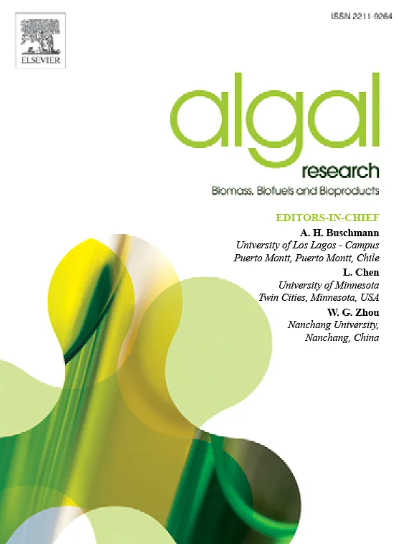马尾藻中叶绿素单宁的超声辅助酶提取、结构表征及酪氨酸酶抑制机理研究
IF 4.6
2区 生物学
Q1 BIOTECHNOLOGY & APPLIED MICROBIOLOGY
Algal Research-Biomass Biofuels and Bioproducts
Pub Date : 2025-04-15
DOI:10.1016/j.algal.2025.104038
引用次数: 0
摘要
紫紫丹素作为天然酪氨酸酶抑制剂,其有效性和安全性得到了公认,但由于其提取效率有限,其作用机制难以捉摸,因此面临着挑战。在这里,我们开发了一种超声波辅助酶萃取(UAEE)方案,该方案显著提高了马尾藻褐藻素的回收率,总酚含量(TPC)达到21.51 mg PGE/g DW。随后采用溶剂萃取和Sephadex LH-20纯化得到高纯度藻酸盐褐藻宁(SHP),具有较强的DPPH自由基清除和酪氨酸酶抑制活性,IC50值分别为22.71和26.90 μg/mL。基于NMR和MS数据的结构解析表明,SHP主要由岩藻酚醇组成,聚合度在3到8之间。互反图分析表明,SHP通过竞争性抑制机制抑制酪氨酸酶活性,荧光光谱分析显示SHP对酪氨酸酶具有动态猝灭作用。分子对接研究进一步阐明了范德华力和疏水相互作用是控制SHP与酪氨酸酶相互作用的主要力量。细胞实验表明,SHP对B16-F10细胞黑色素生成和酪氨酸酶活性均有显著抑制作用。本研究为开发新型酪氨酸酶抑制剂提供了有前景的先导化合物,同时也为马尾藻的综合利用提供了理论和方法基础。本文章由计算机程序翻译,如有差异,请以英文原文为准。

Ultrasonic assisted enzymatic extraction, structural characterization, and tyrosinase inhibition mechanism of phlorotannins from Sargassum horneri
Phlorotannins, recognized for their efficacy and safety as natural tyrosinase inhibitors, have posed challenges due to their limited extraction efficiency and the elusive nature of their mechanism of action. Here, we developed an ultrasonic-assisted enzymatic extraction (UAEE) protocol that significantly enhanced phlorotannin recovery from Sargassum horneri, achieving a total phenolic content (TPC) of 21.51 mg PGE/g DW. Subsequent purification using solvent extraction and Sephadex LH-20 yielded high-purity alginate phlorotannins (SHP), exhibiting potent DPPH radical scavenging and tyrosinase inhibitory activities, with IC50 values of 22.71 and 26.90 μg/mL, respectively. Structural elucidation based on NMR and MS data suggested that SHP predominantly comprises fucophloroethols, with a degree of polymerization ranging from 3 to 8. Reciprocal plot analysis indicated that SHP inhibits tyrosinase activity through a competitive inhibition mechanism, while fluorescence spectroscopy revealed a dynamic quenching effect of SHP on tyrosinase. Molecular docking studies further elucidated that van der Waals forces and hydrophobic interactions are the primary forces governing the interaction between SHP and tyrosinase. Cellular experiments demonstrated the significant inhibitory effects of SHP on both melanin production and tyrosinase activity in B16-F10 cells. This research presents promising lead compounds for the development of novel tyrosinase inhibitors, while also providing theoretical and methodological foundations for the comprehensive utilization of Sargassum horneri.
求助全文
通过发布文献求助,成功后即可免费获取论文全文。
去求助
来源期刊

Algal Research-Biomass Biofuels and Bioproducts
BIOTECHNOLOGY & APPLIED MICROBIOLOGY-
CiteScore
9.40
自引率
7.80%
发文量
332
期刊介绍:
Algal Research is an international phycology journal covering all areas of emerging technologies in algae biology, biomass production, cultivation, harvesting, extraction, bioproducts, biorefinery, engineering, and econometrics. Algae is defined to include cyanobacteria, microalgae, and protists and symbionts of interest in biotechnology. The journal publishes original research and reviews for the following scope: algal biology, including but not exclusive to: phylogeny, biodiversity, molecular traits, metabolic regulation, and genetic engineering, algal cultivation, e.g. phototrophic systems, heterotrophic systems, and mixotrophic systems, algal harvesting and extraction systems, biotechnology to convert algal biomass and components into biofuels and bioproducts, e.g., nutraceuticals, pharmaceuticals, animal feed, plastics, etc. algal products and their economic assessment
 求助内容:
求助内容: 应助结果提醒方式:
应助结果提醒方式:


